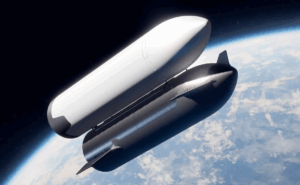What is it and what is the history behind it?
Will it be possible for an average citizen to explore space one day? In the mid-1900s the idea of space exploration became popular in countries across the world. This interest sparked the Space Race, a twentieth-century competition between the Soviet Union and the United States. The objective was to develop aerospace capabilities, like satellites and human spaceflight (1).
On October 4, 1957, the first official satellite called Sputnik was launched by the Union of Soviet Socialist Republics (U.S.S.R.). This satellite successfully orbited the earth. It was also able to send out signals from a radio transmitter which could be detected on the ground. The United States grew concerned knowing that the U.S.S.R had better technology that could potentially harm them. In response, President Eisenhower began prioritizing space exploration in the U.S in 1958. A new government agency known as the National Aeronautics and Space Administration (NASA) was formed. On January 31, 1958, the U.S. launched Explorer 1, the first U.S. satellite in space (2).
Yuru Gagarin was a Soviet cosmonaut, and the first human to ever travel to space. He made one orbit around the earth on April 12, 1961. This flight lasted a hundred and eight minutes (3). Ever since then, Russia and the United States have led the way for many more trips to space. This includes the Apollo 11 mission, where astronauts Neil Armstrong and Buzz Aldrin landed and walked on the Moon (4).
The era of Space Tourism started on April 28, 2001, when American businessman Dennis Tito went to the International Space Station (ISS). Space tourism is recreational space travel on government vehicles or vehicles fielded by private companies. It is divided into three different categories: orbital, suborbital, and lunar space tourism. After vigorous training required for the mission, and twenty million dollars exhausted on his flight, Tito spent seven days on the Russian spacecraft Soyuz TM-32 (5). Orbital space tourism continued to grow after Tito’s mission. In about twenty years, one hundred and sixty-one people from twenty different countries visited the ISS (6). There are currently four major companies that are planning to expand the tourist flight aspect of their business: Virgin Galactic, Blue Origin, SpaceX, and Axiom Space (7).
On April 8, 2022, the first all-civilian crew launched on a mission to the ISS. Jared Isaacman, the commander of the mission, funded three civilian seats alongside him; he also donated a hundred million dollars to St. Judes Children’s Research Hospital. The first crew member Hayley Arceneaux received treatment from St. Jude. The remaining two seats were given a way in two different competitions. Chris Sembroksi, a data engineer, obtained his seat from a St. Judes fundraiser. Sian Proctor, a geology and planetary science professor and science communication specialist, was awarded her seat as the winner of the Shift4Shop competition, which asked entrants to use an e-commerce platform owned by Isaacman to showcase their businesses. The flight was organized by the Houston-based company Axiom Space. The crew traveled aboard Space X’s Dragon Endeavor spacecraft. The Axiom Mission also known as Ax-1 included Commander Michael Lopez-Alegria of Spain, Larry Connor of the United States, and Mission Specialists Eytan Stibbe of Israel and Mark Pathy of Canada (8).
Another recent space tourist launch was a sub-orbital spaceflight mission operated by Blue Origin. This mission called NS-22 launched on August 4, 2022, using the New Shepard rocket. The flight lasted 10 minutes and 20 seconds. On board were six civilians: Coby Cotton, Mario Ferreira, Vanessa O’Brien, Clint Kelly III, Sara Sabry, and Steve Young. The capsule reached an altitude of about three hundred thousand feet above the earth (9).
In summary, human spaceflight, which was once limited to individual governments and their space agencies, has blossomed into a prospering commercial enterprise. The potential danger of space tourism would be that only the wealthy or those that are experts in these fields will be available to take advantage of this journey. Government companies like NASA are skeptical about space tourism. NASA states that space tourism flights disrupt important space exploration missions. Space tourism will continue in the future, but everyone will not benefit from it.
Dennis Tito, the first space tourist (1)
Yuri Gagarin, Soviet cosmonaut, first man to go to space (2)
Space X’s first all-civilian space flight (3)
Bibliography
- History.com Editors. (2010, February 22). The Space Race. HISTORY; HISTORY. https://www.history.com/topics/cold-war/space-race
- https://www.jpl.nasa.gov. (2022). Explorer 1 – Earth Missions – NASA Jet Propulsion Laboratory. NASA Jet Propulsion Laboratory (JPL). https://www.jpl.nasa.gov/missions/explorer-1
- History.com Editors. (2010, February 9). Soviet cosmonaut Yuri Gagarin becomes the first man in space. HISTORY; HISTORY. https://www.history.com/this-day-in-history/first-man-in-space
- Timeline of the Apollo Space Missions | Britannica. (2022). In Encyclopædia Britannica. https://www.britannica.com/story/timeline-of-the-apollo-space-missions
- space tourism | Companies, History, & Facts | Britannica. (2022). In Encyclopædia Britannica. https://www.britannica.com/topic/space-tourism
- Visitors to the Station by Country. (2016). NASA. https://www.nasa.gov/feature/visitors-to-the-station-by-country/
- Technology, V. (2021, October 28). Space Tourism: Can A Civilian Go To Space? Star Walk; Vito Technology, Inc. https://starwalk.space/en/news/space-tourism
- Manny Jawa. (2022, April 8). Axiom Space. Axiom Space. https://www.axiomspace.com/news/ax-1-mission-launches-successfully-4-private-astronauts-en-route-to-space-station
- Howell, E. (2022, July 23). Blue Origin announces crew for 6th suborbital space tourism launch. Space.com; Space. https://www.space.com/blue-origin-crew-ns-22-announced
Images Bibliography
1.Street, F. (2021, April 30). First space tourist Dennis Tito: “It was the greatest moment of my life.” CNN; CNN. https://www.cnn.com/travel/article/space-tourism-20-year-anniversary-scn/index.html?gallery=1
2. Remembering Yuri Gagarin 50 Years Later. (2014). NASA. https://www.nasa.gov/feature/remembering-yuri-gagarin-50-years-later
3.https://www.engadget.com/about/editors/jon-fingas. (2021). Meet SpaceX’s first all-civilian flight crew | Engadget. Engadget; Engadget. https://www.engadget.com/spacex-inspiration4-mission-full-crew-143428383.html






Comments are closed.